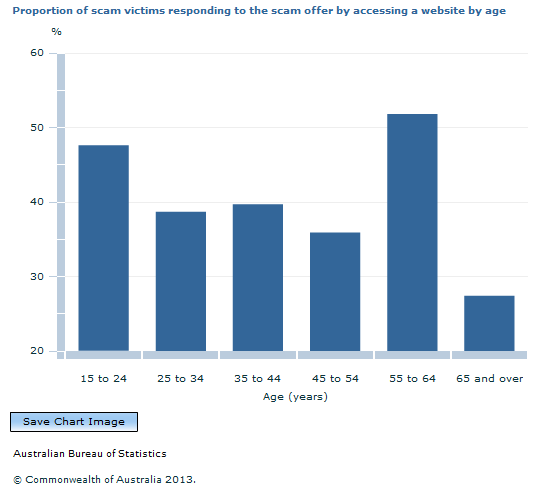Page tools:
 Print Page Print Page
 Print All Print All
| ||||
SEX, AGE AND MARITAL STATUS The proportion of people exposed to a scam (but who did not necessarily respond to the scam) was higher for males than for females (37.1% compared to 34.6%), although there was no statistically significant difference in the proportion of people who responded to a scam (and are therefore considered a victim of a scam) by sex (3.0% and 2.8% respectively). Male victims were also more likely than female victims to respond to a scam notification or offer by asking for more information (76.5% compared to 68.3%), while there was no difference in the likelihood of male and female victims responding by accessing a website, sending details, or accepting an offer. People aged 15 to 24 years and 55 years and over were both less likely to be exposed to a scam (25.9% and 33.0%) and less likely to be a victim of a scam (2.0% and 2.2%) than respondents in the other age groups. When examining the different ways in which scam victims received a scam, including email or internet, phone, fax or SMS, in person, or in the post, scam victims aged 65 years and over were less likely to receive a scam offer via email or through the internet (38.3%) when compared to victims aged 25 to 34 years (62.9%), 35 to 44 years (60.0%), and 55 to 64 years (57.1%). They were however more likely to receive a scam offer via telephone, fax, or SMS, (54.9%) than scam victims aged 15 to 24 years (36.3%), 25 to 34 years (35.5%), and 35 to 44 years (40.4%). .gif) Footnote(s): (a) Scam offer may have been received in more than one way so components may not add to 100%. Source(s): In Focus: Crime and Justice Statistics Around a quarter (27.4%) of scam victims aged 65 years and over responded to a scam by accessing a website. This was lower than the proportion of victims aged 15 to 24 years (47.6%), 25 to 34 years (38.7%), and 55 to 64 years (51.8%) who responded to a scam in the same way.  Source(s): In Focus: Crime and Justice Statistics Both the proportion of people exposed and the proportion of people responding to a scam were higher for married persons than unmarried persons (39.4% compared to 30.3% for exposure, and 3.2% compared to 2.5% for victimisation). Scam victims that were not married were more likely to receive a scam offer or notification through email or internet than married victims (61.2% compared to 52.9%) and respond to a scam by accessing a website (45.4% compared to 37.6%). Conversely, victims that were married were more likely to receive a scam offer or notification through telephone, fax, or SMS (44.6% compared to 34.5%).
|
||||
